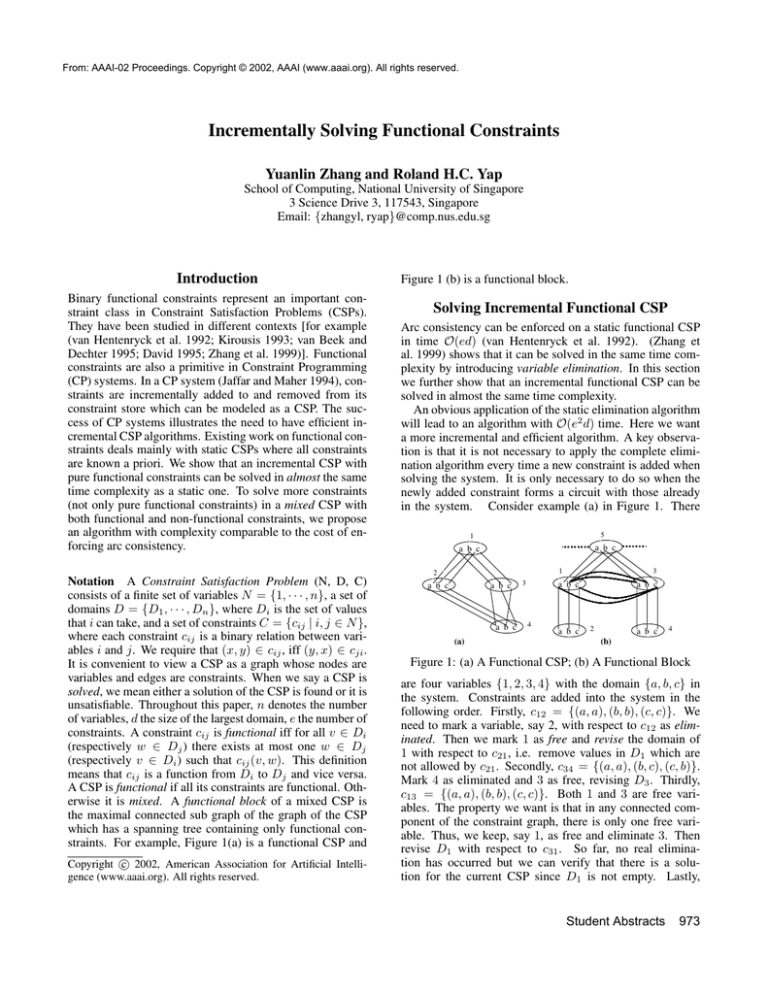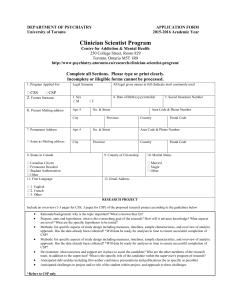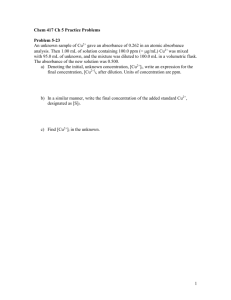
From: AAAI-02 Proceedings. Copyright © 2002, AAAI (www.aaai.org). All rights reserved.
Incrementally Solving Functional Constraints
Yuanlin Zhang and Roland H.C. Yap
School of Computing, National University of Singapore
3 Science Drive 3, 117543, Singapore
Email: {zhangyl, ryap}@comp.nus.edu.sg
Introduction
Binary functional constraints represent an important constraint class in Constraint Satisfaction Problems (CSPs).
They have been studied in different contexts [for example
(van Hentenryck et al. 1992; Kirousis 1993; van Beek and
Dechter 1995; David 1995; Zhang et al. 1999)]. Functional
constraints are also a primitive in Constraint Programming
(CP) systems. In a CP system (Jaffar and Maher 1994), constraints are incrementally added to and removed from its
constraint store which can be modeled as a CSP. The success of CP systems illustrates the need to have efficient incremental CSP algorithms. Existing work on functional constraints deals mainly with static CSPs where all constraints
are known a priori. We show that an incremental CSP with
pure functional constraints can be solved in almost the same
time complexity as a static one. To solve more constraints
(not only pure functional constraints) in a mixed CSP with
both functional and non-functional constraints, we propose
an algorithm with complexity comparable to the cost of enforcing arc consistency.
Figure 1 (b) is a functional block.
Solving Incremental Functional CSP
Arc consistency can be enforced on a static functional CSP
in time O(ed) (van Hentenryck et al. 1992). (Zhang et
al. 1999) shows that it can be solved in the same time complexity by introducing variable elimination. In this section
we further show that an incremental functional CSP can be
solved in almost the same time complexity.
An obvious application of the static elimination algorithm
will lead to an algorithm with O(e2 d) time. Here we want
a more incremental and efficient algorithm. A key observation is that it is not necessary to apply the complete elimination algorithm every time a new constraint is added when
solving the system. It is only necessary to do so when the
newly added constraint forms a circuit with those already
in the system. Consider example (a) in Figure 1. There
5
1
a b c
a b c
1
2
Notation A Constraint Satisfaction Problem (N, D, C)
consists of a finite set of variables N = {1, · · · , n}, a set of
domains D = {D1 , · · · , Dn }, where Di is the set of values
that i can take, and a set of constraints C = {cij | i, j ∈ N },
where each constraint cij is a binary relation between variables i and j. We require that (x, y) ∈ cij , iff (y, x) ∈ cji .
It is convenient to view a CSP as a graph whose nodes are
variables and edges are constraints. When we say a CSP is
solved, we mean either a solution of the CSP is found or it is
unsatisfiable. Throughout this paper, n denotes the number
of variables, d the size of the largest domain, e the number of
constraints. A constraint cij is functional iff for all v ∈ Di
(respectively w ∈ Dj ) there exists at most one w ∈ Dj
(respectively v ∈ Di ) such that cij (v, w). This definition
means that cij is a function from Di to Dj and vice versa.
A CSP is functional if all its constraints are functional. Otherwise it is mixed. A functional block of a mixed CSP is
the maximal connected sub graph of the graph of the CSP
which has a spanning tree containing only functional constraints. For example, Figure 1(a) is a functional CSP and
c 2002, American Association for Artificial IntelliCopyright gence (www.aaai.org). All rights reserved.
a b c
a b c
a b c
(a)
3
3
a b c
4
a b c
a b c
2
a b c
4
(b)
Figure 1: (a) A Functional CSP; (b) A Functional Block
are four variables {1, 2, 3, 4} with the domain {a, b, c} in
the system. Constraints are added into the system in the
following order. Firstly, c12 = {(a, a), (b, b), (c, c)}. We
need to mark a variable, say 2, with respect to c12 as eliminated. Then we mark 1 as free and revise the domain of
1 with respect to c21 , i.e. remove values in D1 which are
not allowed by c21 . Secondly, c34 = {(a, a), (b, c), (c, b)}.
Mark 4 as eliminated and 3 as free, revising D3 . Thirdly,
c13 = {(a, a), (b, b), (c, c)}. Both 1 and 3 are free variables. The property we want is that in any connected component of the constraint graph, there is only one free variable. Thus, we keep, say 1, as free and eliminate 3. Then
revise D1 with respect to c31 . So far, no real elimination has occurred but we can verify that there is a solution for the current CSP since D1 is not empty. Lastly,
Student Abstracts
973
c24 = {(a, a), (b, c), (c, b)}. But both variables 2 and 4
have been eliminated. Here we want to ensure that a new
constraint is only on free variables and not eliminated ones.
Since an eliminated variable is marked with respect to a particular constraint, we can follow this until a free variable
is found. From 4 we get 3 and from 3 we get 1 which is
free. Elimination also occurs during this tracing. A new
constraint c14 = {(a, a), (b, c), (c, b)} is obtained by composing c13 and c34 , and 4 is marked as eliminated with respect to c14 . Discard c34 from the system. Similarly we
trace 2 to 1. The fact that 2 and 4 share the same free variable 1, implies a circuit is formed. We can further eliminate
2 and 4 (compose c12 , c24 , and c41 ) in sequence resulting
in a new unary constraint c11 = {(a, a), (b, c), (c, b)}. We
cannot assign variable b and c simultaneously to variable 1.
Revising D1 with respect to c11 gives D1 = {a}. Discard
constraint c24 and c11 from the system. Now the system
contains {c12 , c14 , c13 } and is satisfiable.
The above example of incremental solving can be implemented efficiently by disjoint set union algorithms (Tarjan 1975):
Theorem 1 Given at time t, a total of e constraints are
added into an incremental functional CSP which has n variables. Using disjoint set union with union by rank and
path compression, the satisfiability of the incremental system can be determined in worst case time complexity of
O(edα(2e, n)), where α is the inverse Ackerman function.
Solving the Functional Block in a Mixed CSP
In a mixed CSP, the algorithm described in previous section does not prune as much as it could given the presence of non-functional constraints. Consider the example
(b) from Figure 1. There are variables {1, 2, 3, 4, 5, . . .}
with domain {a, b, c} in the CSP. Constraints are added into
the system as follows. Firstly, c12 = {(a, a), (b, b), (c, c)}.
Secondly, c34 = {(a, a), (b, c), (c, b)}. They are processed as before. Thirdly, a non-functional constraint,
c13 = {(a, c), (b, b), (b, a), (c, c)}, so ignore. Fourthly,
some other constraints on 5 are added. Fifthly, c15 =
{(a, a), (b, b), (c, c)}. Because of the other functional constraints on 5, we mark 5 as free and 1 as eliminated. Lastly,
c53 = {(a, a), (b, b), (c, c)}. Mark 5 as free and 3 as eliminated.
In this example, nothing is pruned although c13 could
have be actively used to prune D5 . To get better pruning, we
propose an algorithm which eliminates a variable as soon as
possible. Consider the same example again.
Firstly, c12 . Revise D1 with respect to c21 . Secondly,
c34 . Repeat first step. Thirdly, c13 . Fourthly, some other
constraints on 5. Fifthly, c15 . Eliminate 1 immediately.
As a consequence two new constraints are added. The
first is c52 = {(a, a), (b, b), (c, c)}, the composition of c51
and c12 . The second is c53 = {(a, c), (b, b), (b, a), (c, c)}
(composition of c51 and c13 ). Revise D5 with respect to
the two new constraints. Discard c12 and c13 . Sixthly,
c53 = {(a, a), (b, b), (c, c)}. Eliminate 3. Add c54 =
{(a, a), (b, b), (c, c)} (composition of c53 and c34 ) and c55 =
{(a, c), (b, b), (b, a), (c, c)} (composition of c53 and c35 ).
974
Student Abstracts
D5 is revised to be {b, c}. Discard c53 (non-functional) and
c55 . Now the final system has constraints {c51 , c52 , c53 , c54 }
and is satisfiable.
Theorem 2 Given at time t, a total of e constraints are
added into an incremental functional CSP which has n variables. By appropriate choice of elimination variable, any
functional block of a CSP can be solved in a worst case time
complexity of O(ed2 log e).
When adding a functional constraint, the rule is that we
choose to eliminate the variable with more constraints incident on it.
Discussion and Conclusion
The most related work in CSP is bucket elimination
(Dechter 1999), which is designed for a general CSP (NPcomplete) and thus the complexities of corresponding algorithms are high. It may not directly lead to efficient algorithms for both static and incremental functional systems.
The effort here may motivate work on more efficient bucket
elimination algorithms for special classes of constraints.
Two algorithms are proposed to solve functional constraints in an incremental system. They are especially useful
for CP systems (Jaffar and Maher 1994). When applied to
a CP system, the first algorithm is more efficient while the
second may achieve more pruning than the first. The choice
of the two algorithms in a CP system will depend on the
tradeoff between efficiency and pruning ability.
References
van Beek, P. and Dechter, R. 1995. On the Minimality and
Global Consistency of Row-Convex Constraint Networks.
Journal of the ACM, 42(3):543–561.
David, P. 1995. Using Pivot Consistency to Decompose
and Solve Functional CSPs. Journal of Artificial Intelligence Research, 2:447–474.
Dechter, R. 1999. Bucket Elimination: A unifying framework for reasoning. Artificial Intelligence 113:41–85.
Jaffar, J. and Maher, M.J. 1994. Constraint Logic Programming. Journal of Logic Programming 19/20:503–581.
van Hentenryck, P., Deville, Y., and Teng, C.M. 1992.
A Generic Arc-Consistency Algorithm and its Specializations. Artificial Intelligence 58:291–321.
Kirousis, L.M. 1993. Fast Parallel Constraint Satisfaction.
Artificial Intelligence 64:147–160.
Tarjan, R.E. 1975. Efficiency of a good but not linear set
union algorithm. Journal of the ACM, 22(2):146–160.
Zhang, Y., Yap, R.H.C., and J. Jaffar 1999. Functional
Elimination and 0/1/All Constraints. Proceedings of the
16th AAAI, 275–281.



